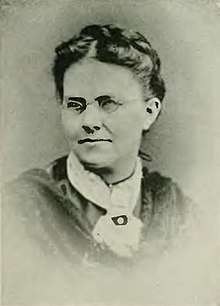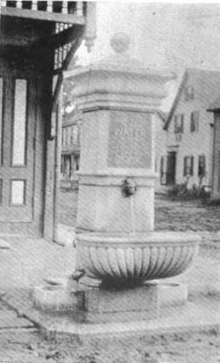Louisa Dow Benton
Louisa Dow Benton (March 23, 1831 – December 7, 1895) was an American linguist, translator,[1] and letter writer. She became physically disabled from rheumatism, unable to walk, and lost almost the entire use of her hands. She learned to read Italian, Spanish, German, Greek, and Russian without any instruction. Then she took up Volapük, and became well-known as a Volapük scholar. She carried on correspondence with several linguists in Europe and associations for the spreading of this language. [2]
Louisa Dow Benton | |
|---|---|
 "A woman of the century" | |
| Born | Louisa Dwight Dow March 23, 1831 Portland, Maine, U.S. |
| Died | December 7, 1895 (aged 64) Lancaster, New Hampshire, U.S. |
| Occupation | Linguist, translator, letter-writer, scholar |
| Language | English, Volapük |
| Nationality | American |
| Alma mater | Free Street Seminary |
| Subject | Volapük |
| Spouse | |
| Relatives | Neal Dow (father) |
Early years and education
Louisa Dwight Dow[3] was born in Portland, Maine, March 23, 1831. She was the eldest child of General Neal Dow and Maria Cornelia Durant Maynard Dow.[4][2] Her siblings included Emma Maynard Dow, Frederick Neal Dow, and Cornelia Maria Dow.[5]
She was educated in the best schools of Portland, the last and chief of which was the Free Street Seminary for young ladies, Master Hezekiah Packard, teacher. She had, besides these, teachers in French.[4]
Career
On December 12, 1860, she married Jacob Benton, of Lancaster, New Hampshire. They passed four seasons in Washington, D.C., while Mr. Benton was a member of Congress,[4][2] after which they resided at "Benton Manor" in Lancaster.[6]
In the fall of 1887, she contracted rheumatism. She went several times to mineral springs in Canada, and to Hot Springs, Arkansas, but derived no benefit from any of them. Eventually, she could not walk or stand; she passed the time with reading books, writing, drawing and painting. Her hands and arms were so greatly and increasingly affected by the disease that she stopped drawing and painting, and devoted herself to the acquisition of languages, a study which was always especially attractive to her. She learned to read fluently Italian, Spanish, German, Greek and Russian, all with no teacher except for Greek. After that, she took up the Volapük and mastered it easily. She was so well known as a Volapük scholar that correspondence came to her from several prominent linguists in Europe, and several European Volapük associations elected her corresponding member.[4]
Personal life

Benton designed and gave a fountain to the town of Lancaster in memory of her husband, who died from the effects of an accident in the fall of 1892. He had long been a resident of the town and had attained prominence as a lawyer, business man and politician. This memorial fountain was erected on the corner of Main and Mechanic streets, directly in front of the doorway of the Town Hall building. It was inscribed with the following memorial: "In memory of Jacob Benton as a gift to the town this fountain was erected by his wife Louisa D. Benton, on the day of his death September 29, 1892."[7]
She died at her home in Lancaster on December 7, 1895, from the effects of an operation for the removal of a cancer.[8]
References
Citations
- "Feminine Fancies". Newspapers.com. The Pensacola News. 7 October 1891. p. 4. Retrieved 7 April 2019.

- Logan 1912, p. 788.
- Metcalf & Robinson 1892, p. 352.
- Willard & Livermore 1893, p. 77.
- Wait 2002, p. 59.
- Making of America Project 1906, p. 597.
- Somers 1899, p. 160.
- "Death of a Daughter of Neal Dow". Newspapers.com. The Washington Times. 8 December 1895. p. 1. Retrieved 7 April 2019.

Attribution





Bibliography
- Wait, Eugene M. (2002). The Second Jackson Administration. Nova Publishers. ISBN 978-1-59033-305-1.CS1 maint: ref=harv (link)